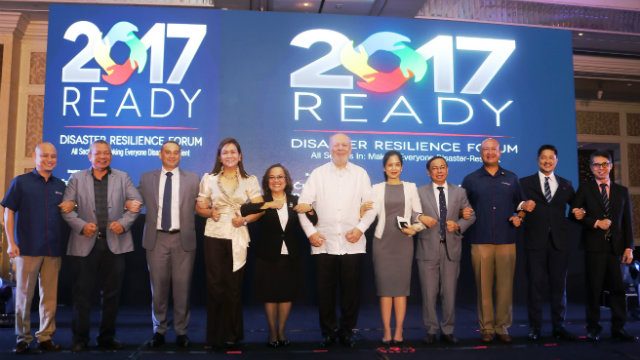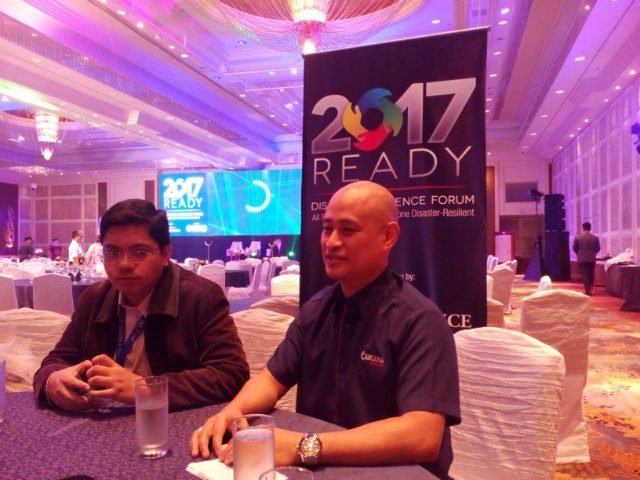SUMMARY
This is AI generated summarization, which may have errors. For context, always refer to the full article.

MANILA, Philippines – What is a ready culture in agriculture?
This is the question that speakers tried to answer during the 2017 Ready Disaster Resilience Forum held in Makati City on Wednesday, August 9.
The forum aimed to discuss ways to foster disaster resilience in sectors most vulnerable to calamities – micro, small, and medium enterprises; high-risk and marginalized communities; and farmers and fisherfolk.
It was convened by Cebuana Lhuillier Micro Insurance with the support of the Insurance Commission, the Climate Change Commission, and the Deutsche Gesellschaft für Internationale Zusammenarbeit (GIZ), a Germany-based provider of international cooperation services for sustainable development and international education work.
“When it comes to natural disasters, even events like climate change and El Niño, the most affected sector is always agriculture. The most vulnerable are the small-scale farmers and fishers, so sometimes when we look at this, like in Tacloban, how many were affected, after this shock…the farmers and fishers have lost agriculture assets or fishing gear and cannot catch up with their activities,” said Jose Luis Fernandez, representative of the Food and Agriculture Organization (FAO) of the United Nations in the Philippines.
In previous years, according to Fernandez, the total damage and losses from natural disasters were estimated by the Philippine government at $3.8 billion, with further estimated damage of more than 6 million hectares of crops.
There is a need to strengthen resilience of communities regularly exposed to national disasters and to build capacities of local government units in order to build back better, said Fernandez.
“With proper risk management, agriculture insurance is viable in the Philippines,” said Norman Cajucom, senior vice president of the Philippine Crop Insurance Corporation (PCIC), who encouraged private insurance providers to engage in agriculture insurance, and to expand it for the protection of farmers.
“PCIC is willing to share its expertise and information to the private sector so there can be a healthy, successful public-private partnership,” said Cajucom.
Adaptation, risk mitigation
As of 2017, there are some 10.033 million agriculture workers, representing 23% of the labor force, reported Jimmy Loro, senior adviser for micro agriculture insurance of Deutsche Gesellschaftfür Internationale Zusammenarbeit (GIZ). Around 32% of the land area (9.671 million hectares) is used in agriculture, with 14.478%, some 1.4 million hectares, used for rice.
To help them, Loro said, “It should be a combination of two things: adaptation and risk mitigation.” Farmers should be trained to adapt, and to use varieties that are flood resistant, alongside adaptation in areas, such as the strengthening of flood canals to prevent inundation.
Loro encouraged further measures, such as direct linkages in providing loans with crop insurance, and that crop insurance should be open to all stakeholders involved in the value chain.
“If we have a product that we can sell to market based on weather index, and let it be sold to all stakeholders in the agriculture value chain, I think we can diversify and spread the risk so that risk is not concentrated in some areas.”
This is a view supported by Jean Henri Lhuillier, president and CEO of the PJ Lhuillier Group of Companies, who said, in the closing remarks: “We are a country whose food security depends on many of our farmers and fisherfolks, and with an economy greatly benefitting from the growing MSME sector. With so much at stake, it is only right that we extend as much help as we can.”
“Our goal is to empower farmers, fisherfolks, micro and small enterprises, those in high-risk communities, people with disabilities, and the marginally poor,” Lhuillier said.
“Currently, these communities lack the information, protection, and the know-how when it comes to disaster preparedness. Our challenge, following today’s sessions, is to be able to come up with concrete measures and programs that will serve as a catalyst in empowering these communities to be protected and disaster-resilient. Our end-goal is for each and every Filipino to be able to prepare for, respond to and recover from disaster and calamities,” the company CEO added.
Microinsurance: easy accessibility, affordability
Jonathan Batangan, vice president and group head of Cebuana Lhuillier Insurance Solutions, said that “28% of the Filipino population have microinsurance, approximately 28 million.”

“Nationwide, we have more than 4,000 partners and branches, which makes it really very accessible to avail of insurance coverage,” noted Batangan. All that is needed is for anyone interested to go to their nearest Cebuana Lhuillier branch with a valid identification card.
“That’s it! No need for medical exam. If you’re from 7 to 70 years old you can buy our Alagang Cebuana for 40 pesos, 10 pesos a month for four months. It has life, it has non-life. Even if your house burns, you’ll be covered,” said Batangan. “These are the benefits of microinsurance: the practicability, the affordability, and the value proposition. We can promote this to the grassroots level.”
An online platform, protectnow.ph, will soon be introduced, as well as an app called Micropinoy, available for download on android devices, as well as for iOS users. There is also an existing partnership with telecommunications providers to promote mobile microinsurance, where through a simple text message, coverage is available for just P10. – Rappler.com
Add a comment
How does this make you feel?
There are no comments yet. Add your comment to start the conversation.